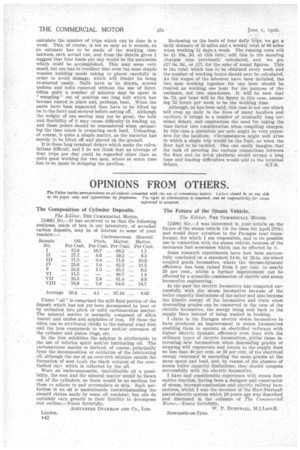OPINIONS FROM OTHERS.
Page 56

If you've noticed an error in this article please click here to report it so we can fix it.
The Editor invites corre.spondence on all subjects connected with the use of commercial motors. Leiters should be on one side of the paper only and typewritten by preferenoe. The right of abbreviation is reserved, and no responsibility for views
expressed is accepted.
The Composition of Cylinder Deposits, The Editor, THE COMMERCIAL MOTOR.
[2498] Sir,-It has occurred to us that the following analyses, made of late in our laboratory, of so-called carbon deposits, may be of interest to some of your readers: Under " oil " is comprised the still fluid portion of the deposit which has not yet been decomposed by beat or by oxidation into pitch or solid carbonaceous matter. The mineral matter is normally composed of silica (sand) and oxides and sulphides of iron. Of these the silica can be attributed chiefly to the induced road dust and the iron compounds to wear and/or corrosion of the cylinder and piston rings, etc.
In the iron sulphides the sulphur is attributable to the use of inferior spirit and/or lubricating oil. The carbonaceous matter is derived, of course, principally from the decomposition or oxidation of the lubricating oil, although the use of an over-rich mixture entails the formation of soot (vide the black exhaust of the overfuelled car) which is collected by the oil.
Were an undecomposable, unoxidizable oil a possibility, the soot and the mineral matter would be blown out of the cylinders, as there would be no medium for them to adhere to and accumulate in situ. Such perfection in an oil is unobtainable (notwithstanding the absurd claims made by some oil vendors), but oils do certainly vary greatly in their liability to dectimpose and oxidize.-Yours faithfully, ALEXANDER DUCKHAM A7SD CO., LTD. London.
B42
The Future of the Steam Vehicle.
The Editor, THE COMMERCIAL MOTOR.
[24991 Sir,-I was interested in your article on the future of the steam vehicle (in the issue for April 27th) and would draw attention to the Paragon heat transformer, for which I am responsible, and to its possible use in connection with the steam vehicle, because of the enormous fuel economies which can be effected by it.
Some research experiments have now been successfully concluded on a standard 14-in. by 22-in, six-wheel coupled goods locomotive, where the thermo-dynamic efficiency has been raised from 5 per cent, to nearly 20 per cent., whilst a further improvement can he effected by a scientific combination of electric and steam locomotive engineering.
In the past the electric locomotive has competed successfully with the steam locomotive because of the boiler capacity limitations of the latter and also because the kinetic energy of the locomotive and train when descending grades can be conserved in the case of the electric locomotive, the energy being sent back to the supply lines instead of being wasted in braking.
I claim in the Paragon electric steam locomotive to have produced an improvement in steam locomotives enabling them to operate on electrified railways with. higher electric dynamic efficiency even than with the ordinary types of electric locomotives, .whilst these interesting new locomotives when descending grades or stopping will regenerate and return to the supply lines no less than 40 per cent. or 50 per cent, of the electrical energy consumed in ascending the same grades at the same speed and load, and, by reason of the absence of steam boiler capacity limitations, they should compete successfully with the electric locomotive.
I have had considerable experience with steam locomotive traction, having been a designer and constructor of steam, internal-combustion and electric railway loco
• motives, whilst I was the inventor of the Hart-Durtnall petrol-electric system which 20 years ago was described and discussed in the columns of The Commercial Motor.-Yours faithfully,
IV, P. DURTNALL,
Newcastle-on-Tyne.


























































